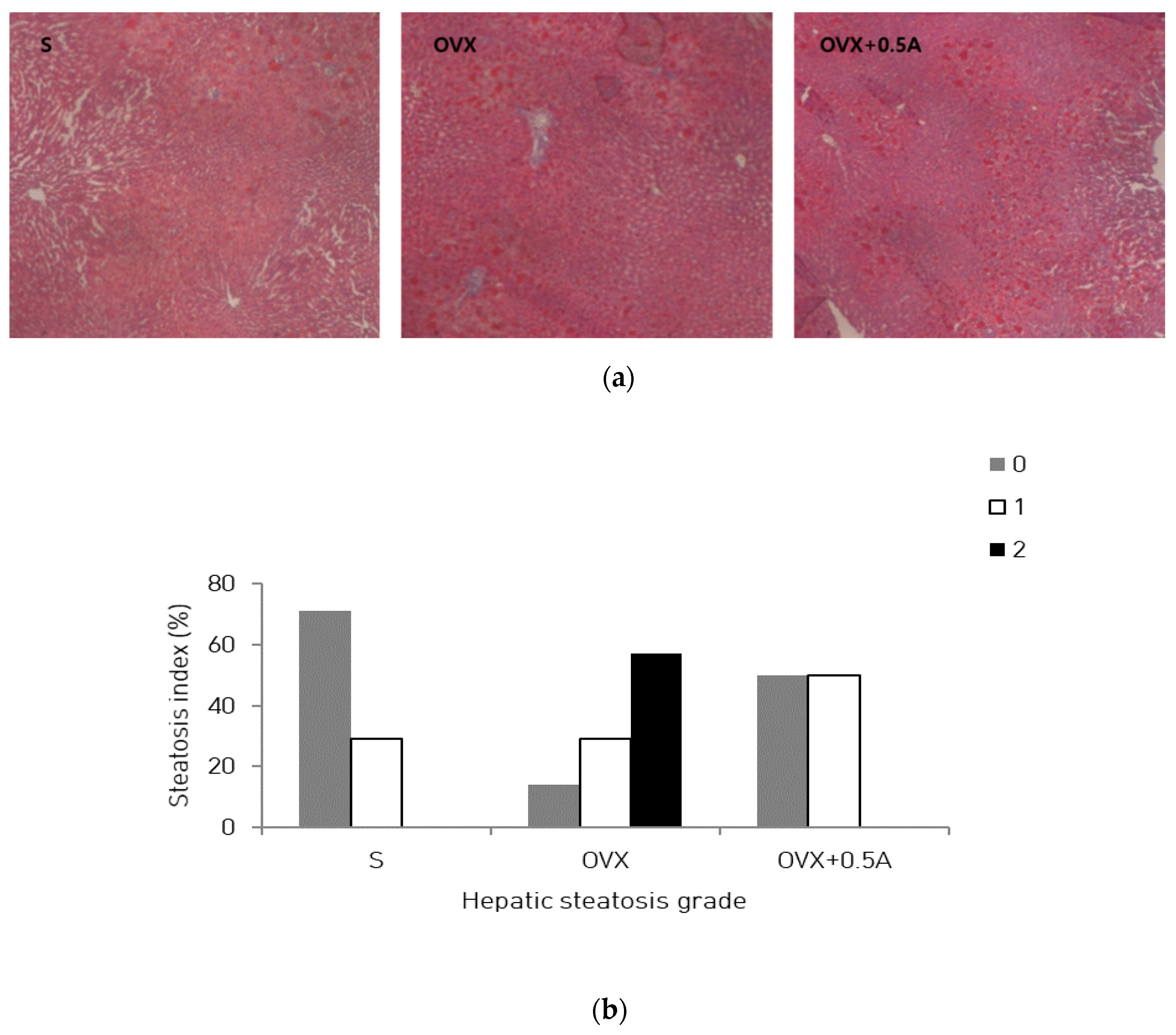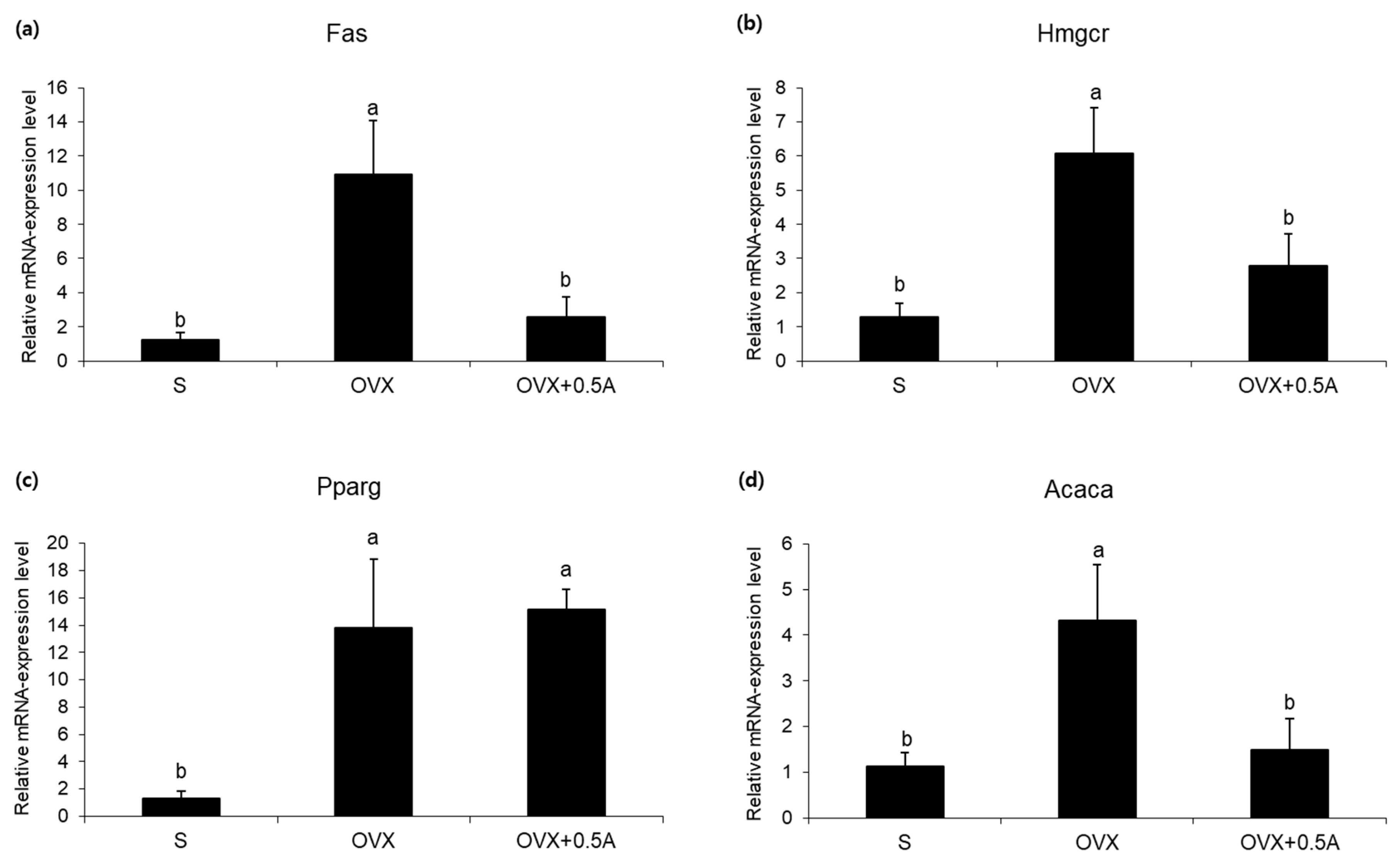Agrimonia pilosa Ledeb. Ameliorates Hyperglycemia and Hepatic Steatosis in Ovariectomized Rats Fed a High-Fat Diet
Abstract
1. Introduction
2. Materials and Methods
2.1. Preparation of Aqueous Extract from A. pilosa
2.2. Experiment Animals and Diets
2.3. Blood and Tissue Collection for Biochemical Analysis
2.4. Biochemical Serum Analysis
2.5. Real-Time Quantitative Reverse Transcription PCR
2.6. Liver Histology
2.7. Statistical Analysis
3. Results
3.1. Effects of A. pilosa on Body Weight, Food Intake, Food-Efficiency Ratio (FER), and Organ Weight
3.2. Effects of A. pilosa on Serum Lipid Levels
3.3. Effects of A. pilosa on Serum Metabolic Parameters
3.4. Effect of A. pilosa on Hepatic Steatosis
3.5. Effects of A. pilosa Supplementation on Lipid-Metabolism-Related Gene Expression
4. Discussion
5. Conclusions
Supplementary Materials
Author Contributions
Funding
Conflicts of Interest
References
- Kannel, W.B.; Levy, D.J. Menopause, hormones, and cardiovascular vulnerability in women. Arch. Intern. Med. 2004, 164, 479–481. [Google Scholar] [CrossRef] [PubMed]
- Carr, M.C. The emergence of the metabolic syndrome with menopause. J. Clin. Endocrinol. Metab. 2003, 88, 2404–2411. [Google Scholar] [CrossRef] [PubMed]
- Bagger, Y.Z.; Tankó, L.B.; Alexandersen, P.; Qin, G.; Christiansen, C.; PERF Study Group. Early postmenopausal hormone therapy may prevent cognitive impairment later in life. Menopause 2005, 12, 12–17. [Google Scholar] [CrossRef] [PubMed]
- Jeong, Y.-H.; Hur, H.J.; Jeon, E.-J.; Park, S.-J.; Hwang, J.T.; Lee, A.S.; Lee, K.W.; Sung, M.J.J.M. Honokiol improves liver steatosis in ovariectomized mice. Molecules 2018, 23, 194. [Google Scholar] [CrossRef]
- Grady, D.; Rubin, S.M.; Petitti, D.B.; Fox, C.S.; Black, D.; Ettinger, B.; Ernster, V.L.; Cummings, S.R. Hormone therapy to prevent disease and prolong life in postmenopausal women. Ann. Intern. Med. 1992, 117, 1016–1037. [Google Scholar] [CrossRef]
- Manson, J.E.; Chlebowski, R.T.; Stefanick, M.L.; Aragaki, A.K.; Rossouw, J.E.; Prentice, R.L.; Anderson, G.; Howard, B.V.; Thomson, C.A.; LaCroix, A.Z.; et al. Menopausal hormone therapy and health outcomes during the intervention and extended poststopping phases of the Women’s Health Initiative randomized trials. JAMA 2013, 310, 1353–1368. [Google Scholar] [CrossRef]
- Persson, I.; Weiderpass, E.; Bergkvist, L.; Bergström, R.; Schairer, C. Risks of breast and endometrial cancer after estrogen and estrogen–progestin replacement. Cancer Causes Control 1999, 10, 253–260. [Google Scholar] [CrossRef]
- Rossouw, J.E.; Prentice, R.L.; Manson, J.E.; Wu, L.; Barad, D.; Barnabei, V.M.; Ko, M.; LaCroix, A.Z.; Margolis, K.L.; Stefanick, M.L. Postmenopausal hormone therapy and risk of cardiovascular disease by age and years since menopause. JAMA 2007, 297, 1465–1477. [Google Scholar] [CrossRef]
- Patisaul, H.B.; Jefferson, W.J. The pros and cons of phytoestrogens. Front. Neuroendocrinol. 2010, 31, 400–419. [Google Scholar] [CrossRef]
- Glazier, M.G.; Bowman, M.A. A review of the evidence for the use of phytoestrogens as a replacement for traditional estrogen replacement therapy. Arch. Intern. Med. 2001, 161, 1161–1172. [Google Scholar] [CrossRef]
- Kuryłowicz, A.; Cąkała-Jakimowicz, M.; Puzianowska-Kuźnicka, M. Targeting abdominal obesity and its complications with dietary phytoestrogens. Nutrients 2020, 12, 582. [Google Scholar] [CrossRef] [PubMed]
- Noh, D.; Lim, Y.; Lee, H.; Kim, H.; Kwon, O. Soybean-hop alleviates estrogen deficiency-related bone loss and metabolic dysfunction in ovariectomized rats fed a high-fat diet. Molecules 2018, 23, 1205. [Google Scholar] [CrossRef] [PubMed]
- Tanaka, T.; Yokota, Y.; Tang, H.; Zaima, N.; Moriyama, T.; Kawamura, Y. Anti-hyperglycemic effect of a kudzu (Pueraria lobata) vine extract in ovariectomized mice. J. Nutr. Sci. Vitaminol. 2016, 62, 341–349. [Google Scholar] [CrossRef] [PubMed]
- Miyamoto, K.; Kishi, N.; Koshiura, R. Antitumor effect of agrimoniin, a tannin of Agrimonia pilosa Ledeb., on transplantable rodent tumors. Jpn. J. Pharmacol. 1987, 43, 187–195. [Google Scholar] [CrossRef]
- He, C.; Ji, X.; Pan, Y.; Wang, H.; Wang, K.; Liang, M.; Yang, L. Antioxidant activity of alcoholic extract of Agrimonia pilosa Ledeb. Med. Chem. Res. 2010, 19, 448–461. [Google Scholar] [CrossRef]
- Jung, C.H.; Kim, J.H.; Park, S.; Kweon, D.H.; Kim, S.H.; Ko, S.G. Inhibitory effect of Agrimonia pilosa Ledeb. on inflammation by suppression of iNOS and ROS production. Immunol. Investig. 2010, 39, 159–170. [Google Scholar] [CrossRef]
- Lee, Y.M.; Kim, J.B.; Bae, J.H.; Lee, J.S.; Kim, P.-S.; Jang, H.H.; Kim, H.R. Estrogen-like activity of aqueous extract from Agrimonia pilosa Ledeb. in MCF-7 cells. BMC Complement Med. Ther. 2012, 12, 260. [Google Scholar] [CrossRef]
- Kim, S.M.; Lee, Y.M.; Kim, M.J.; Nam, S.Y.; Kim, S.H.; Jang, H.H. Effects of Agrimonia pilosa Ledeb. water extract on α-glucosidase inhibition and glucose uptake in C2C12 skeletal muscle cells. Korean J. Food Nutr. 2013, 26, 806–813. [Google Scholar] [CrossRef]
- Jang, H.H.; Nam, S.Y.; Kim, M.J.; Kim, J.B.; Choi, J.S.; Kim, H.R.; Lee, Y.M. Agrimonia pilosa Ledeb. aqueous extract improves impaired glucose tolerance in high-fat diet-fed rats by decreasing the inflammatory response. BMC Complement Altern. Med. 2017, 17, 442. [Google Scholar] [CrossRef]
- Friedewald, W.T.; Levy, R.I.; Fredrickson, D.S. Estimation of the concentration of low-density lipoprotein cholesterol in plasma, without use of the preparative ultracentrifuge. Clin Chem 1972, 18, 499–502. [Google Scholar] [CrossRef]
- Kleiner, D.; Brunt, E.; Van Natta, M.f.; Behling, C.; Contos, M.; Cummings, O.; Ferrell, L.; Liu, Y.; Torbenson, M.; Unalp-Arida, A.J.; et al. Design and validation of a histological scoring system for nonalcoholic fatty liver disease. Hepatology 2005, 41, 1313–1321. [Google Scholar] [CrossRef] [PubMed]
- Hart-Unger, S.; Arao, Y.; Hamilton, K.J.; Lierz, S.L.; Malarkey, D.E.; Hewitt, S.C.; Freemark, M.; Korach, K.S. Hormone signaling and fatty liver in females: Analysis of estrogen receptor α mutant mice. Int J Obes 2017, 41, 945–954. [Google Scholar] [CrossRef] [PubMed]
- Seo, Y.-J.; Lee, K.; Song, J.-H.; Chei, S.; Lee, B.-Y. Ishige okamurae extract suppresses obesity and hepatic steatosis in high fat diet-induced obese mice. Nutrients 2018, 10, 1802. [Google Scholar] [CrossRef] [PubMed]
- Polyzos, S.A.; Kountouras, J.; Zavos, C. Nonalcoholic fatty liver disease: The pathogenetic roles of insulin resistance and adipocytokines. Curr. Mol. Med. 2009, 9, 299–314. [Google Scholar] [CrossRef]
- Frayn, K.N. Insulin resistance, impaired postprandial lipid metabolism and abdominal obesity. Med. Princ. Pract. 2002, 11, 31–40. [Google Scholar] [CrossRef]
- Savvidou, S.; Hytiroglou, P.; Orfanou-Koumerkeridou, H.; Panderis, A.; Frantzoulis, P.; Goulis, J. Low serum adiponectin levels are predictive of advanced hepatic fibrosis in patients with NAFLD. J. Clin. Gastroenterol. 2009, 43, 765–772. [Google Scholar] [CrossRef]
- Pagano, C.; Soardo, G.; Esposito, W.; Fallo, F.; Basan, L.; Donnini, D.; Federspil, G.; Sechi, L.A.; Vettor, R. Plasma adiponectin is decreased in nonalcoholic fatty liver disease. Eur. J. Endocrinol. 2005, 152, 113–118. [Google Scholar] [CrossRef]
- Targher, G.; Bertolini, L.; Scala, L.; Poli, F.; Zenari, L.; Falezza, G. Decreased plasma adiponectin concentrations are closely associated with nonalcoholic hepatic steatosis in obese individuals. Clin. Endocrinol. 2004, 61, 700–703. [Google Scholar] [CrossRef]
- Polyzos, S.A.; Kountouras, J.; Zavos, C.; Tsiaousi, E. The role of adiponectin in the pathogenesis and treatment of non-alcoholic fatty liver disease. Diabetes Obes. Metab. 2010, 12, 365–383. [Google Scholar] [CrossRef]
- Li, J.; Xue, Y.M.; Zhu, B.; Pan, Y.H.; Zhang, Y.; Wang, C.; Li, Y. Rosiglitazone elicits an adiponectin-mediated insulin-sensitizing action at the adipose tissue-liver axis in Otsuka Long-Evans Tokushima fatty rats. J. Diabetes Res. 2018, 2018, 4627842. [Google Scholar] [CrossRef]
- Tawfik, S.H.; Mahmoud, B.F.; Saad, M.I.; Shehata, M.; Kamel, M.A.; Helmy, M.H. Similar and additive effects of ovariectomy and diabetes on insulin resistance and lipid metabolism. Biochem. Res. Int. 2015, 2015, 567945. [Google Scholar] [CrossRef] [PubMed]
- Rao, J.R.; Keating, D.J.; Chen, C.; Parkington, H.C. Adiponectin increases insulin content and cell proliferation in MIN6 cells via PPARγ-dependent and PPARγ-independent mechanisms. Diabetes Obes. Metab. 2012, 14, 983–989. [Google Scholar] [CrossRef] [PubMed]
- Ma, H.; Cui, F.; Dong, J.J.; You, G.P.; Yang, X.J.; Lu, H.D.; Huang, Y.L. Therapeutic effects of globular adiponectin in diabetic rats with nonalcoholic fatty liver disease. World J. Gastroenterol. 2014, 20, 14950. [Google Scholar] [CrossRef] [PubMed][Green Version]
- Fortis-Barrera, M.d.l.Á.; Alarcón-Aguilar, F.J.; Becerril-García, A.; Flores-Sáenz, J.L.E.; Almanza-Pérez, J.C.; García-Lorenzana, M.; Lazzarini-Lechuga, R.C.; Román-Ramos, R.; Blancas-Flores, G. Mechanism of the hypoglycemic activity and hepatoprotective effect of the aqueous extract of Cecropia obtusifolia Bertol. J. Food Med. 2019. [Google Scholar] [CrossRef]
- Lee, H.R.; Kim, J.E.; Goo, J.S.; Choi, S.I.; Hwang, I.S.; Lee, Y.J.; Son, H.J.; Lee, H.S.; Lee, J.S.; Hwang, D.Y. Red Liriope platyphylla contains a large amount of polyphenolic compounds which stimulate insulin secretion and suppress fatty liver formation through the regulation of fatty acid oxidation in OLETF rats. Int. J. Mol. Med. 2012, 30, 905–913. [Google Scholar] [CrossRef]
- Wielogorska, E.; Blaszczyk, K.; Chevallier, O.; Connolly, L. The origin of in-vitro estrogen-like activity in oregano herb extracts. Toxicol. In Vitro 2019, 56, 101–109. [Google Scholar] [CrossRef]
- Jung, U.J.; Cho, Y.-Y.; Choi, M.-S. Apigenin ameliorates dyslipidemia, hepatic steatosis and insulin resistance by modulating metabolic and transcriptional profiles in the liver of high-fat diet-induced obese mice. Nutrients 2016, 8, 305. [Google Scholar] [CrossRef]


| S 1 | OVX | OVX + 0.5A | |
|---|---|---|---|
| Initial body weight (BW), g | 276.2 ± 2.8 2,NS,3 | 276.2 ± 2.8 | 276.2 ± 2.8 |
| OVX (at 0 week) BW, g | 288.5 ± 6.6 b | 334.3 ± 6.4 a | 338.0 ± 8.4 a |
| Final BW (after 4 weeks), g | 336.6 ± 11.8 b | 393.8 ± 9.1 a | 389.4 ± 6.1 a |
| Weight gain (after 4 weeks), g | 48.1 ± 8.3 NS | 59.5 ± 5.7 | 58.5 ± 4.6 |
| Intake (for 4 weeks), g/d | 18.3 ± 0.7 b | 21.0 ± 0.6 a | 20.9 ± 0.7 a |
| FER 4 (for 4 weeks) | 0.09 ± 0.01 NS | 0.10 ± 0.01 | 0.11 ± 0.01 |
| S 1 | OVX | OVX + 0.5A | |
|---|---|---|---|
| TG, mg/dL | 71.80 ± 2.14 2,NS,3 | 69.69 ± 12.18 | 60.00 ± 2.06 |
| Total cholesterol, mg/dL | 115.23 ± 6.22 NS | 163.85 ± 36.95 | 121.17 ± 12.49 |
| HDL cholesterol, mg/dL | 18.08 ± 1.11 b | 32.24 ± 3.53 a | 37.03 ± 3.28 a |
| LDL cholesterol, mg/dL | 81.25 ± 7.78 NS | 120.84 ± 35.09 | 69.21 ± 12.74 |
| Free fatty acid, μM | 205.26 ± 10.82 a | 192.09 ± 35.53 a,b | 128.97 ± 18.63 b |
| AI 4 | 5.55 ± 1.14 a | 5.97 ± 1.45 a | 1.89 ± 0.35 b |
| S 1 | OVX | OVX + 0.5A | |
|---|---|---|---|
| Insulin, pM | 322.05 ± 35.51 2,b,3 | 462.88 ± 58.43 b | 765.33 ± 104.24 a |
| Glucose, mg/dL | 163.12 ± 12.58 a,b | 193.86 ± 18.00 a | 143.70 ± 8.53 b |
| Leptin, pM | 548.9 ± 59.9 2,NS,3 | 728.3 ± 158.3 | 736.7 ± 54.9 |
| Adiponectin, µg/mL | 13.34 ± 1.44 b | 11.99 ± 1.57 b | 20.75 ± 2.73 a |
© 2020 by the authors. Licensee MDPI, Basel, Switzerland. This article is an open access article distributed under the terms and conditions of the Creative Commons Attribution (CC BY) license (http://creativecommons.org/licenses/by/4.0/).
Share and Cite
Jang, H.-H.; Bae, J.H.; Kim, M.-J.; Park, M.Y.; Kim, H.R.; Lee, Y.-M. Agrimonia pilosa Ledeb. Ameliorates Hyperglycemia and Hepatic Steatosis in Ovariectomized Rats Fed a High-Fat Diet. Nutrients 2020, 12, 1631. https://doi.org/10.3390/nu12061631
Jang H-H, Bae JH, Kim M-J, Park MY, Kim HR, Lee Y-M. Agrimonia pilosa Ledeb. Ameliorates Hyperglycemia and Hepatic Steatosis in Ovariectomized Rats Fed a High-Fat Diet. Nutrients. 2020; 12(6):1631. https://doi.org/10.3390/nu12061631
Chicago/Turabian StyleJang, Hwan-Hee, Ji Hyun Bae, Mi-Ju Kim, Mi Young Park, Haeng Ran Kim, and Young-Min Lee. 2020. "Agrimonia pilosa Ledeb. Ameliorates Hyperglycemia and Hepatic Steatosis in Ovariectomized Rats Fed a High-Fat Diet" Nutrients 12, no. 6: 1631. https://doi.org/10.3390/nu12061631
APA StyleJang, H.-H., Bae, J. H., Kim, M.-J., Park, M. Y., Kim, H. R., & Lee, Y.-M. (2020). Agrimonia pilosa Ledeb. Ameliorates Hyperglycemia and Hepatic Steatosis in Ovariectomized Rats Fed a High-Fat Diet. Nutrients, 12(6), 1631. https://doi.org/10.3390/nu12061631





